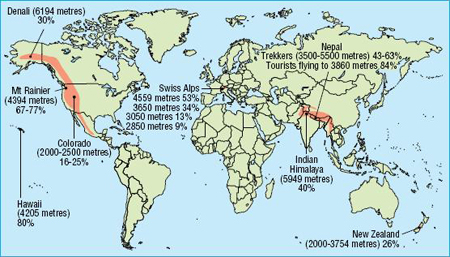შეჯამება
განსაზღვრება
ანამნეზი და გასინჯვა
ძირითადი დიაგნოსტიკური ფაქტორები
- headache
- ataxia
- change in mental state: for example, tired, irritable, confused, forgetful, irrational
- abnormal tone, power, and reflexes
სხვა დიაგნოსტიკური ფაქტორები
- nausea, vomiting, and loss of appetite
- fatigue and weakness
- dizziness or lightheadedness
- difficulty sleeping
- visual disturbance
- shortness of breath
- cough with or without sputum
- rales
- peripheral edema
- accentuated pulmonary second sound
- pyrexia
- elevated respiratory rate
- elevated heart rate
- low arterial oxygen saturation
- cyanosis
- urinary incontinence or retention
- retinal hemorrhages and papilledema on fundoscopy
- chest pain
- cranial nerve palsies (III, IV, and VI)
- visual and auditory hallucinations, seizures, tinnitus, vertigo, tremors, speech disturbance, and deafness
რისკფაქტორები
- high altitude
- rapid ascent
- low-altitude residence
- history of previous altitude illness
- younger age
- exertion
- poor awareness of high-altitude illness prior to travel
- existing medical condition
დიაგნოსტიკური კვლევები
1-ად შესაკვეთი გამოკვლევები
- clinical diagnosis
გასათვალისწინებელი კვლევები
- arterial blood gases
- chest radiography
- ECG
- chest ultrasound and echocardiography
- WBC count
- lumbar puncture
- CT head
- MRI head
მკურნალობის ალგორითმი
high-altitude ascent planned
AMS
HAPE only
HACE only
concurrent HAPE and HACE
კონტრიბუტორები
ავტორები
Jeremy S. Windsor, MBChB, DCH, FCARCSI
Specialist Registrar
Anaesthetics and Intensive Care Medicine
University College Hospital
London
UK
გაფრთხილება:
JSW is an author of a number of references cited in this topic.
რეცენზენტები
James S. Milledge, MBBS
Honorary Professor
Department of Physiology
University College London
London
UK
გაფრთხილება:
JSM declares that he has no competing interests.
Mike Grocott, MD
Senior Lecturer
Intensive Care Medicine
University College Hospital
London
UK
გაფრთხილება:
MG declares that he has no competing interests.
Haibo Wang, MD, PhD
Assistant Professor
LSU Health Sciences Center
Shreveport
LA
გაფრთხილება:
HW declares that he has no competing interests.
რეცენზენტების განცხადებები
BMJ Best Practice-ის თემების განახლება სხვადასხვა პერიოდულობით ხდება მტკიცებულებებისა და რეკომენდაციების განვითარების შესაბამისად. ქვემოთ ჩამოთვლილმა რეცენზენტებმა თემის არსებობის მანძილზე კონტენტს ერთხელ მაინც გადახედეს.
გაფრთხილება
რეცენზენტების აფილიაციები და გაფრთხილებები მოცემულია გადახედვის მომენტისთვის.
წყაროები
ძირითადი სტატიები
Centers for Disease Control and Prevention. CDC Yellow Book 2024: health information for international travel. Section 4: environmental hazards & risks - high elevation travel & altitude illness. May 2023 [internet publication].სრული ტექსტი
Roach RC, Hackett PH, Oelz O, et al. The 2018 lake louise acute mountain sickness score. High Alt Med Biol. 2018 Mar;19(1):4-6.სრული ტექსტი აბსტრაქტი
Luks AM, Auerbach PS, Freer L, et al. Wilderness medical society clinical practice guidelines for the prevention and treatment of acute altitude illness: 2019 update. Wilderness Environ Med. 2019 Dec;30(4s):S3-18.სრული ტექსტი აბსტრაქტი
Donegani E, Paal P, Küpper T, et al. Drug use and misuse in the mountains: a UIAA MedCom consensus guide for medical professionals. High Alt Med Biol. 2016 Sep;17(3):157-84. აბსტრაქტი
Ritchie ND, Baggott AV, Andrew Todd WT. Acetazolamide for the prevention of acute mountain sickness - a systematic review and meta-analysis. J Travel Med. 2012 Sep-Oct;19(5):298-307.სრული ტექსტი აბსტრაქტი
გამოყენებული სტატიები
ამ თემაში მოხსენიებული წყაროების სრული სია ხელმისაწვდომია მომხმარებლებისთვის, რომლებსაც აქვთ წვდომა BMJ Best Practice-ის ყველა ნაწილზე.

დიფერენციული დიაგნოზები
- Asthma, acute exacerbation
- Community-acquired pneumonia
- Acute exacerbation of chronic heart failure (CHF)
მეტი დიფერენციული დიაგნოზებიგაიდლაინები
- CDC Yellow Book: health information for international travel - high elevation travel & altitude illness
- Wilderness Medical Society practice guidelines for the prevention and treatment of acute altitude illness: 2019 update
მეტი გაიდლაინებიშედით სისტემაში ან გამოიწერეთ BMJ Best Practice
ამ მასალის გამოყენება ექვემდებარება ჩვენს განცხადებას